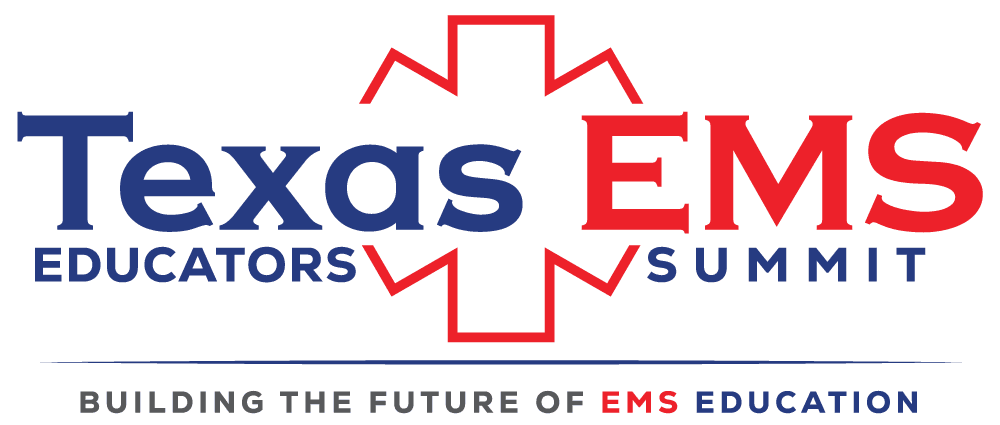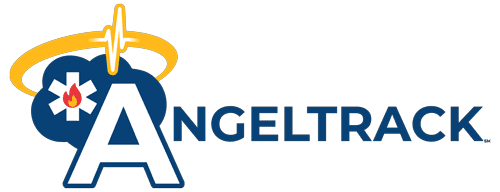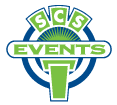Attendees
Join friends, colleagues and fellow educators at the 12th Annual Texas EMS Educators Summit for an opportunity to connect and network all while earning up to 14 hours (additional hours available with Pre-conference course) of quality continuing education. Registration includes a Welcome Reception on Friday, breakfast on Saturday and Sunday, plus snacks and lunch on Saturday.
Preliminary agenda and registration details for the 2026 Texas EMS Educators Summit are now available.
Explore details below or use the Register Now button to register.
Registration Options & Fees
| Now – February 19, 2026 | February 20 – April 12, 2026 | |
| Full Conference TAEMSE Member |
$305 | $345 |
| Full Conference Non-TAEMSE Member |
$340 | $380 |
| Pre-conference Courses | See Below for Pricing |
| Now – February 19, 2026 | February 20 – April 12, 2026 | |
| TAEMSE Member | $305 | $345 |
| TAEMSE Non-Member | $340 | $380 |
| Precon Courses | See Rates Below |
Full Conference registration includes access to all Educators Summit education sessions on Friday, Saturday, & Sunday. Registration also includes a Welcome Reception on Friday, light snacks during breaks, breakfast on Saturday & Sunday, as well as lunch on Saturday. Pre-conference Course registration is NOT included in the Educators Summit registration fee.
Please see the available Pre-conference Courses, including details and pricing below.
Membership sign-up is available through the Texas Association of EMS Educators website or as an option on the Texas EMS Educators Summit online registration form.
Pre-Conference Courses
The following Pre-conference courses are avilable at Texas EMS Educators Summit 2026. See details and pricing below.
Obstetric Life Support (OBLS): A Comprehensive Simulation-Based Curriculum for Maternal Medical Emergencies
Andrea Shields
Jacqueline Vidosh
Leslie Hernandez
$200
Thursday, April 9, 2026
1.5 Hours for Lunch on Your Own
South Shore Harbour
8:00 AM - 5:30 PM
Learn More
The Obstetric Life Support (OBLS) Course is a validated, interdisciplinary training program designed to improve maternal-fetal outcomes during obstetric and maternal medical emergencies, including cardiac arrest. The curriculum is delivered in two integrated components. Part 1 is a self-paced, online course (~4 hours) with fourteen interactive modules. Content covers normal and abnormal maternal adaptations, early warning signs in pregnancy and postpartum, causes of maternal cardiac arrest, pregnancy-specific CPR modifications, post-arrest care, stroke, trauma, postpartum emergencies, obstetric emergency deliveries, medical complications in pregnancy, and communication skills, including handoffs and delivering difficult news. Participants must complete all modules and an online competency assessment prior to simulation training. Part 2 consists of immersive, in-person simulation (~8 hours). Using rapid-cycle deliberate practice under experienced instructor guidance, participants apply pre-course knowledge in case-based scenarios. Skills are reinforced through structured simulations of maternal cardiac arrest, obstetric emergency deliveries, and medical crises in pregnancy. Learners are evaluated on their ability to lead team responses, implement evidence-based algorithms, and communicate effectively under pressure. Together, these components ensure participants develop the cognitive, technical, and leadership skills required for high-stakes maternal emergencies, filling a critical gap in current resuscitation and obstetric training programs. For more information on course content, contact Andrea Shields at ashields@uchc.edu.
Connecting Reality
Scotty Bolleter
Stephen Rahm
$150
Friday, April 10, 2026
South Shore Harbour
7:30 AM - 11:30 AM
Learn More
The connection between truly knowing human anatomy and procedural success is extremely clear (and we can prove it). Using the examples of ventilation management and vascular access we will demonstrate why the current teaching standard is harmful to both patient and student (and how we can implement positive change in the near future). Join Mr. Rahm and Mr. Bolleter on a journey that will open more than just minds and classrooms. For more information on course content, contact Scotty Bolleter at scotty.bolleter@hiscentre.com.
The Poor Man’s Guide to Moulage
Dave Quinn
Tom Maliszewski
John Spencer
$150
Friday, April 10, 2026
South Shore Harbour
7:30 AM - 11:30 AM
Learn More
This four-hour, hands-on workshop is designed to aid instructors in creating realistic moulage and simulation scenes without costing a fortune. Participants will explore practical, budget-conscious techniques to enhance the visual and environmental realism of simulation scenarios. Through guided instruction, demonstration, and active participation, learners will gain foundational knowledge of moulage principles and develop the skills needed to apply moulage effectively in a variety of educational settings. By the end of the workshop, participants will be able to describe at least five core principles of moulage, identify multiple sources for obtaining moulage materials, and recognize creative options for sourcing scenario props. Learners will also apply their knowledge by properly moulaging a simulated patient based on a specific injury or pathophysiological condition, reinforcing both realism and educational impact. This interactive workshop emphasizes hands-on practice, collaboration, and immediately applicable skills for simulation-based education. For more information on course content, contact Dave Quinn at dave.quinn@platinumed.com.
DSHS Sponsored Coordinator Course
A DSHS sponsored Coordinator Course will be offered as part of the 12th Annual Texas EMS Educators Summit.
Until February 19, 2026: $575
February 20-April 8, 2026: $675
Wednesday, April 8, 2026
Afternoon Snacks Provided
South Shore Harbour
1:00 - 5:00 PM
Thursday, April 9, 2026
Breakfast, Lunch & Snacks Provided
South Shore Harbour
7:30 AM - 4:50 PM
Learn More
Candidates should be prepared for two fast paced and intense days of classroom instruction to prepare to become a Course Coordinator. After attending and completing the full course and successfully passing the Coordinator Course exam, candidates will be provided a course completion certificate. Candidates have one year and up to three attempts to successfully pass the certification exam. You are encouraged to review the requirements for certification listed in the link below before you register for the course or apply for certification; you will be asked to attest that you have reviewed and meet the requirements for certification when registering for the course. The DSHS certification process can be found at the following link (EMS Course Coordinator rule: EMS Rule §157.43). For information on EMS Coordinator certification requirements contact Jaime Vallejo, DSHS (jaime.vallejo@dshs.texas.gov) or for more information on class content, contact Jeff McDonald (jeff.mcdonald@sbcglobal.net).
2025 Summit Schedule-At-A-Glance
Wednesday, April 8, 2026
1:00 - 5:00 PM
Coordinator Course
Thursday, April 9, 2026
7:30 AM - 4:50 PM
Coordinator Course
Thursday, April 9, 2026
Educators Summit Pre-Conference Courses
8:00 AM - 5:30 PM
Pre-Conference Course: Obstetric Life Support (OBLS): A Comprehensive Simulation-Based Curriculum for Maternal Medical Emergencies
Andrea Shields
Jacqueline Vidosh
Leslie Hernandez
Course Description & Objectives
This class is designed to introduce attendees to the use of point of care ultrasound in the pre-hospital setting. Students will learn very basic ultrasound function, the most practical use of ultrasound handheld devices and explore a few basic exams. Objectives: understand basic function of handheld ultrasound device / operate pocus device at a beginner level / recognize anatomy of key ultrasound images / perform one or two key ultrasound images.
Friday, April 10, 2026
Educators Summit Pre-Conference Courses
7:30 AM - 11:30 AM
Pre-Conference Course: Connecting Reality
Scotty Bolleter
Stephen Rahm
Course Description & Objectives
This class is designed to introduce attendees to the use of point of care ultrasound in the pre-hospital setting. Students will learn very basic ultrasound function, the most practical use of ultrasound handheld devices and explore a few basic exams. Objectives: understand basic function of handheld ultrasound device / operate pocus device at a beginner level / recognize anatomy of key ultrasound images / perform one or two key ultrasound images.
7:30 AM - 11:30 AM
Pre-Conference Course: The Poor Man’s Guide to Moulage
Dave Quinn
Tom Maliszewski
John Spencer
Friday, April 10, 2026
Educators Summit
1:00 - 1:10 PM
Welcome to the Summit
1:10 - 2:10 PM
Friday Keynote
2:20 - 4:30 PM
Concurrent Education Sessions
4:30 - 5:45 PM
Welcome Reception
5:45 - 6:45 PM
TAEMSE – Annual Membership Meeting
Saturday, April 11, 2026
7:55 - 8:00 AM
Day Two Summit Announcements
8:00 - 8:50 AM
Saturday Keynote
9:00 - 9:50 AM
Concurrent Education Sessions
9:50 - 10:30 AM
Break with Exhibitors
10:30 AM - 12:20 PM
Concurrent Education Sessions
1:30 - 2:20 PM
Concurrent Education Sessions
2:20 - 2:50 PM
Break with Exhibitors
2:50 - 4:40 PM
Concurrent Education Sessions
Sunday, April 12, 2026
8:00 AM - 12:00 PM
Concurrent Education Sessions
Payment
Payment of registration fees may be made by credit card or check. Credit card payments are accepted through the online registration system.
To pay by check, make checks payable to: Sladek Conference Services, Inc.
Send checks to: Sladek Conference Services, Inc., PO Box 187, Lampasas, TX 76550.
No registrations by check will be accepted after March 6, 2026.
Refunds
Refunds may be requested through March 6, 2026, subject to a 20% administrative fee. No refunds will be given after March 6, 2026.
Terms & Conditions
By registering for the Texas EMS Educators Summit, attendees agree to the following Terms and Conditions. With registration you agree to have your likeness reproduced in any summit publications. Conferees assume all risk incidental to participation in all onsite activities, loss or damage to property, and release management, its employees and agents against all claims.



